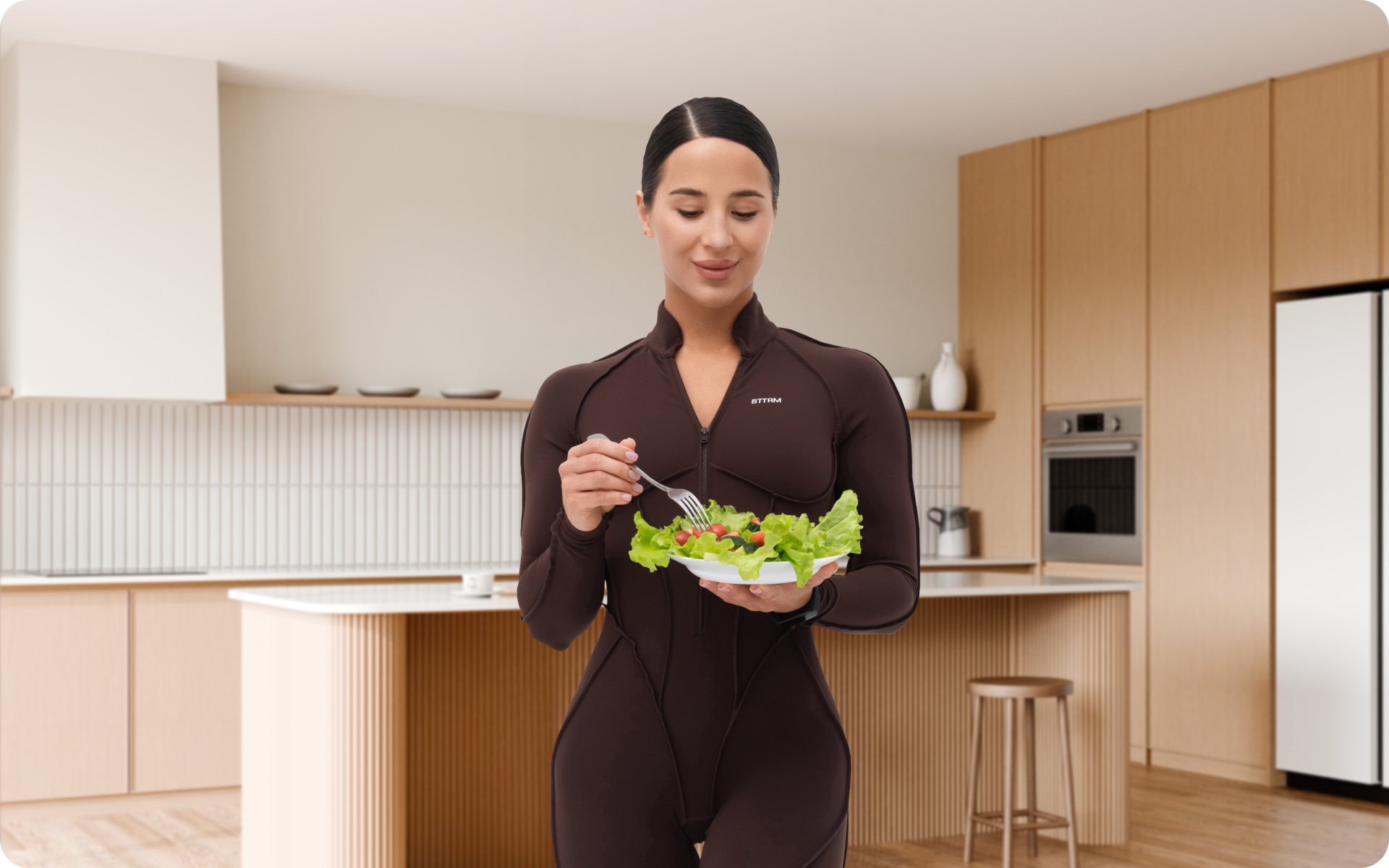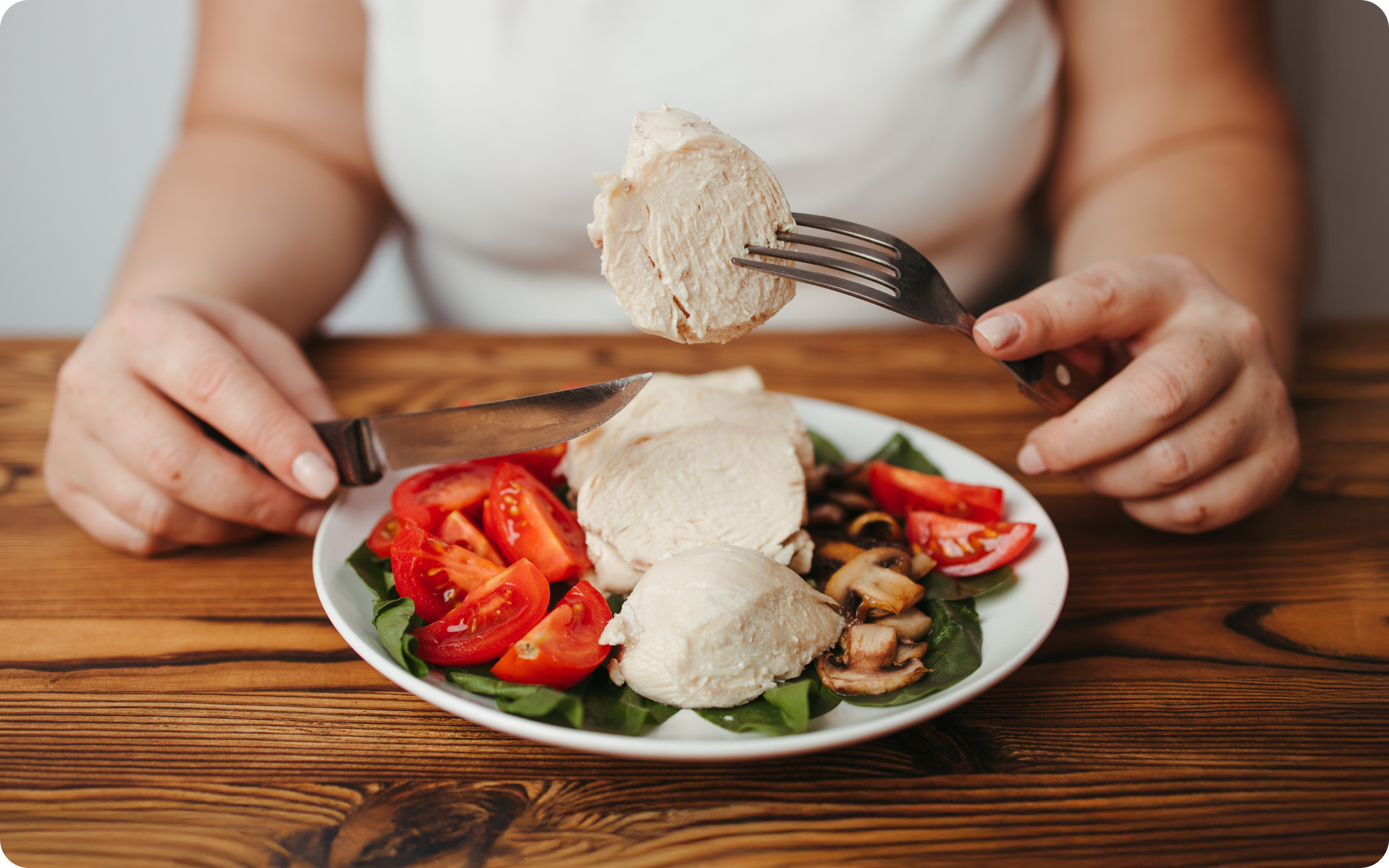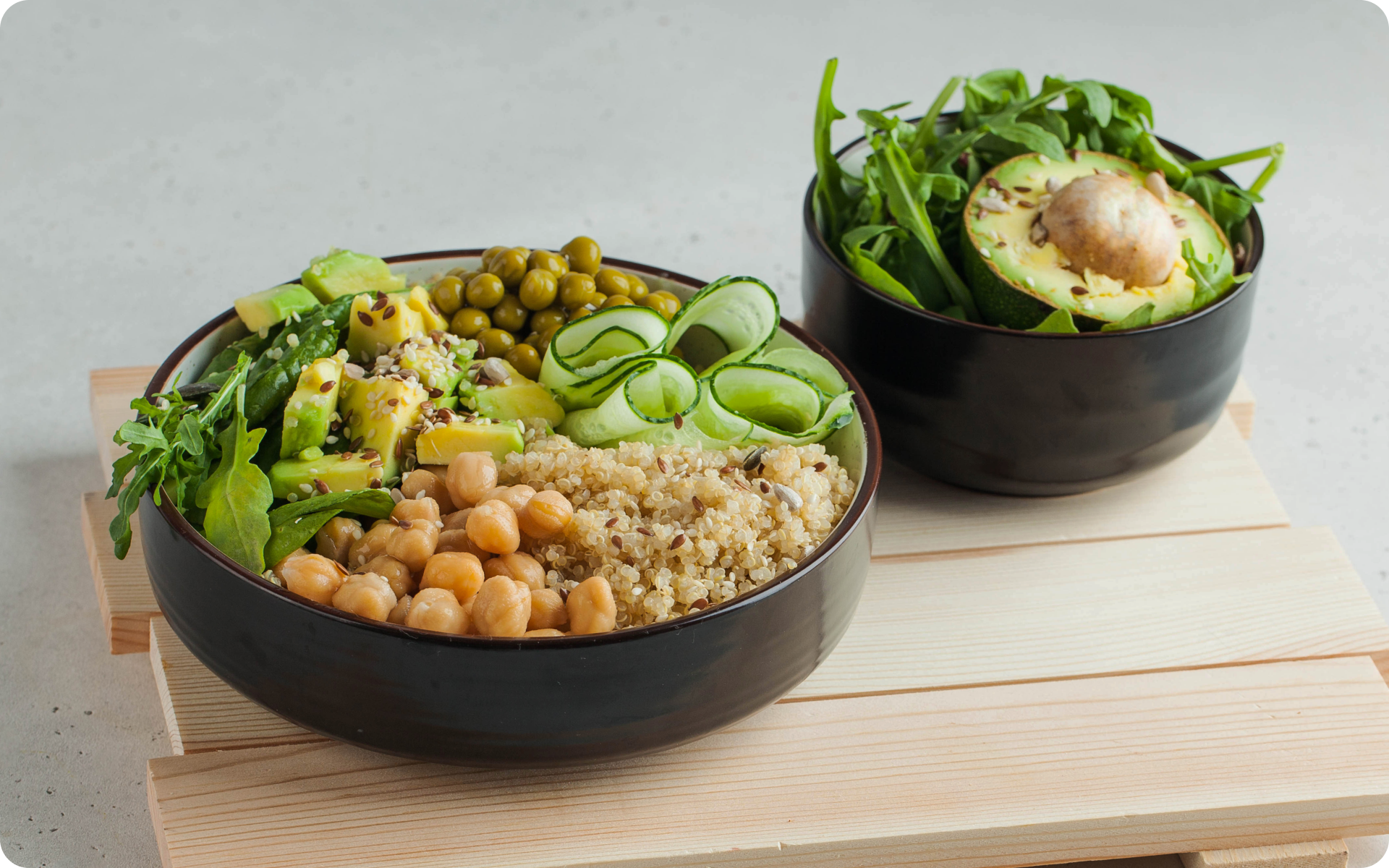Intermittent Fasting (IF) comes in many variations; some will have you eat all of your daily calories within a specific window, while others will have you fast for a certain number of hours and then eat normally. Others have you fasting on alternate days, while some will have you restrict your calorie intake for two days a week.
One of the more popular versions of IF is known as the “One Meal a Day” (OMAD) diet, which is exactly what it sounds like – eating just one meal a day.
At first, the concept of only eating one meal a day may seem extreme and potentially unhealthy. However, proponents of the OMAD diet claim that it can offer numerous benefits beyond just weight loss.
What Is OMAD Diet?
The One Meal a Day diet is a type of intermittent fasting where an individual consumes all of their daily calories in one sitting, typically within a one-hour window. This means that for the rest of the day they are in a state of fasting and do not consume any additional calories.
Although this may seem restrictive, and it is, proponents of the OMAD diet argue that it is more natural for humans to eat one large meal a day rather than several smaller meals throughout the day. They believe that our ancestors followed this eating pattern and that our bodies are designed to function optimally with this type of eating.
There are several reasons why people may choose to follow the OMAD diet, including:
- Weight Loss: By limiting the number of calories consumed in a day, the OMAD diet can lead to weight loss. The body will start burning stored fat for energy during the fasting period (4).
- Simplicity: With only one meal to plan and prepare, the OMAD diet offers a simple approach to eating. Busy people sometimes find this easier to adhere to compared to traditional diets that require multiple meals and snacks throughout the day.
- Time-Saving: With only one meal to eat, followers of the OMAD diet may save time on meal planning, cooking, and cleaning up.
- Health Benefits: Many people who follow the OMAD diet report perceived improvements in their overall health. This can include improved digestion, increased energy levels, better sleep, and improved mental clarity.
If you struggle to even flirt with the idea of giving up your favorite foods or working out till your legs give way – BetterMe app is here to breathe a fresh perspective into the way you view the weight loss process! Check out the app and experience the fun side of fitness and dieting with BetterMe!
What Are The Rules of OMAD?
The OMAD diet does not have any set rules, but there are some general guidelines that most people follow:
- One-Hour Window: The typical eating window for the OMAD diet is one hour. All of your daily calories should be consumed within a 60-minute period.
- No Snacking: While fasting on the OMAD diet, snacking is not allowed. This means that in between your one meal, you should only consume water or other non-caloric beverages.
- No Calorie Counting: Unlike other diets, the OMAD diet does not require you to count calories or restrict your food choices. However, choose nutrient-dense foods during your one meal to be sure that you are meeting as much of your body’s nutritional needs as possible.
- Nutrient-Dense Meal: Since you are only consuming one meal a day, make sure that it is nutrient-dense and provides as many of the essential vitamins and minerals your body needs as possible in one meal.
- Mindful Eating: Listen to your body’s hunger and fullness signals while following the OMAD diet. This means eating slowly and stopping when you feel satisfied, not overly full (10).
- Hydrate: Drink plenty of water when following the OMAD diet. Not only will it help with weight loss, but it can also prevent dehydration during the fasting period.
- Zero-Calorie Beverages: During the fasting period, zero-calorie beverages such as water, unsweetened black coffee, and unsweetened tea or herbal tea are allowed. Any caloric beverages, like sugary drinks or milk, should be consumed during the one hour eating window.
- Gradual Transition: If you are new to intermittent fasting, gradually transition from short fasts to the OMAD diet instead of jumping straight into it. This can help your body adjust and may prevent some potential negative side effects.
- Gentle Exercise: Make sure you are not overexerting yourself with exercise. Gentle forms of physical activity like walking or yoga are recommended during the fasting period.
Can You Lose Weight By Eating One Meal a Day?
Eating one meal a day is a sure way to limit your caloric intake, which can aid in weight loss. It’s physically impossible to consume an excessive number of calories in one sitting, so the OMAD diet naturally limits your calorie intake.
However, the quality of your one meal is crucial for weight loss. Just because you are eating only one meal does not mean you can ignore the nutritional content of your meal. To see weight loss results and hopefully avoid nutrient deficiencies, it is essential to choose nutrient-dense foods with a balanced macronutrient profile.
Your best bet is to fill up on the following nutrient-dense foods:
- Protein: Protein is essential for maintaining muscle mass and promoting satiety (3), especially when consuming only one meal a day. Choose lean protein sources like chicken, fish, tofu, or legumes.
- Fiber: A high-fiber diet can promote weight loss by keeping you feeling full and regulating blood sugar levels (12). Fill your plate with fruits, vegetables, whole grains, and legumes.
- Healthy Fats: Despite what some may think, healthy fats are crucial for a well-rounded diet. They can help promote satiety and provide necessary nutrients (6). Choose sources like avocados, nuts, seeds, and olive oil or other vegetable oils.
- Whole Grains: Whole grains provide essential vitamins, minerals, and fiber. They can help keep you full and regulate blood sugar levels (7). Choose more whole grain options like quinoa, brown rice, oats, or whole wheat bread.
Read more: 7-Day Weight Loss Low-Carb Diet: Choose High-Protein, High-Fiber, or Ultra-Low-Carb
How Much Weight Will I Lose If I Eat One Meal a Day?
You may lose anywhere between 0.5-2 pounds per week if you consistently consume fewer calories than your body burns. This estimate is based on a daily calorie deficit of 500-1000 calories, which is considered a safe and sustainable rate of weight loss.
However, the amount of weight you lose will depend on several factors such as age, sex, current weight, and activity level, as well as individual genetic differences.
- Age: As we age, our metabolism tends to slow down, making weight loss more challenging (5).
- Sex: Men typically have a higher muscle mass than women, which can increase their metabolic rate and result in faster weight loss (9).
- Current Weight: The more you weigh, the more calories your body needs to maintain its current weight. Therefore, those with a higher starting weight may see more significant weight loss in the beginning.
- Activity Level: Those who are more active burn more calories, which can increase the rate of weight loss (9). However, it’s important to listen to your body and not overexert yourself while following the OMAD diet.
We discuss these concepts in more detail in our guide: How to Lose 50 lb In 2 Months
What Should I Eat for One Meal a Day?
Your meal should consist of a balance of all essential macronutrients- protein, carbohydrates, and healthy fats. It should also include plenty of nutrient-dense foods like fruits, vegetables, whole grains, and lean proteins.
Here is an example of a well-rounded OMAD meal:
- Grilled chicken breast with quinoa and roasted vegetables (carbohydrates/protein/healthy fats)
- Side salad with mixed greens, tomatoes, cucumbers, and balsamic vinaigrette (fiber/healthy fats)
- Fresh fruit for dessert (carbohydrates/fiber/vitamins)
Here’s another example for those following a vegetarian or plant-based diet:
- Tofu stir-fry with mixed vegetables and brown rice (protein/carbohydrates/healthy fats)
- Side of roasted chickpeas (fiber/protein/healthy fats)
- Fresh berries for dessert (carbohydrates/fiber/vitamins)
Yet another example for those following a low-carb or keto diet:
- Grilled salmon with steamed broccoli and cauliflower rice (protein/fiber/healthy fats)
- Side salad with spinach, avocado, and olive oil dressing (fiber/healthy fats)
- Small serving of berries for dessert (carbohydrates/fiber/vitamins)
During your one hour of eating, you may include beverages that aren’t necessarily zero-calorie, such as a glass of milk, a piece of fruit juice, or a sweetened coffee drink. However, it’s important to keep these beverages in moderation and prioritize nutrient-dense foods for your one meal.
Whether you’re a workout beast or just a beginner making your first foray into the world of fitness and dieting – BetterMe has a lot to offer to both newbies and experts! Install the app and experience the versatility first-hand!
What Food Should I Avoid During OMAD?
While there are no specific foods that are off-limits on the OMAD diet, it is crucial to prioritize nutrient-dense options and limit highly processed, high-calorie foods, which provide little to no nutritional value (13).
Here are some foods to avoid or limit while following the OMAD diet:
- Processed snacks and junk food: Chips, cookies, candy, and other highly processed snacks should be limited as they are high in calories and low in nutrients.
- Sugary beverages: Soda, energy drinks, and sweetened coffee drinks can quickly add up in calories and provide little nutritional value.
- Fast food: While it may be tempting to grab a quick meal from a fast-food restaurant during your one hour of eating, these meals are often high in calories and unhealthy fats.
- Alcohol: While a glass of wine or beer can fit within your calorie limit, it’s important to remember that alcohol provides empty calories and little nutritional value. It can also make you want to eat more and may make it more challenging to stick to your one meal a day.
By avoiding or limiting these foods and prioritizing nutrient-dense options, you are more likely to see weight loss results while following the OMAD diet.
Check out this 30 Day Diet Plan for Weight Loss that incorporates the OMAD diet for more meal ideas and tips on how to successfully follow this eating pattern.
Can OMAD Be Harmful?
You may experience intense hunger, fatigue, and difficulty concentrating while following this eating pattern. Your body is not used to going without food for prolonged periods, and it takes time to adapt. Over time, it becomes easier to stick to the OMAD diet, and hunger pangs tend to lessen.
Some people shouldn’t follow the OMAD diet, including (11):
- Individuals with a history of disordered eating: The strict nature of this eating pattern can trigger unhealthy behaviors in those with a history of disordered eating.
- Children and adolescents: They are still growing and have high energy and nutrient needs that cannot be met with one meal a day. Dieting and/or food restriction is also not recommended in general as it can foster an unhealthy relationship with food that lasts a lifetime.
- Pregnant or breastfeeding women: These individuals have increased calorie and nutrient needs and should not restrict their intake to one meal a day.
- Those with certain medical conditions: It’s important to consult with your healthcare provider before starting the OMAD diet if you have any medical conditions that may be affected by extreme calorie restriction, or if you are taking any medications.
- Athletes or highly active individuals: Those with high energy demands may struggle to meet their body’s needs with only one meal a day.
- Anyone who doesn’t feel well: If you experience severe or prolonged side effects, reconsider this eating pattern and consult with a healthcare professional.
Read more: 24 Weight Loss Smoothies, 2 Diet Plans, and 5 Belly Fat Smoothie Secrets
FAQs
Who Should Avoid OMAD?
Individuals with a history of disordered eating, children and adolescents, pregnant or breastfeeding women, those with certain medical conditions, athletes or highly active individuals, and anyone who doesn’t feel well should avoid the OMAD diet. It’s important to consult with a healthcare professional before starting this eating pattern if you fall into one of these categories.
How Many Calories Should I Eat on OMAD?
OMAD isn’t a calorie-strict diet, as its focus is more on the timing of meals rather than specific calorie amounts. Rather than counting calories, it’s important to prioritize nutrient-dense and whole foods during your one hour of eating.
That said, a nutritious, filling meal is likely to contain anywhere from 1000-1500 calories, and you may add a snack or small treat within your one hour.
How Can I Avoid Feeling Overwhelmed While Following OMAD?
Transitioning to the OMAD diet can be challenging, but there are some tips to make it more manageable:
- Start slowly: If you’re new to intermittent fasting or extreme calorie restriction, consider starting with a 16:8 fasting ratio before transitioning to OMAD.
- Stay hydrated: Drink plenty of water throughout the day to help combat hunger pangs and stay hydrated.
- Plan your meal in advance: Having a nutritious, well-rounded meal planned for your one hour of eating can make it easier to stick to the OMAD diet.
- Seek support: Joining an online community or finding an accountability partner can provide motivation and support while following the OMAD diet.
It’s important to listen to your body and make adjustments as needed.
If you’re feeling overwhelmed or experiencing severe side effects, it may be necessary to reconsider this eating pattern and consult with a healthcare professional. It’s always important to prioritize your physical and mental well-being above any specific diet or eating pattern.
What Happens If You Only Eat Once a Day for a Month?
If you only eat once a day for a month, you are likely to lose weight due to the calorie restriction (1). Some people also claim that they notice improvements in your energy levels, digestion, and overall health. You may also:
- Make better food choices – By limiting your eating window, you may become more conscious of the foods you choose to eat during that time and prioritize nutrient-dense options.
- Improve insulin sensitivity – This can lead to better blood sugar control and potentially reduce the risk of developing type 2 diabetes (8).
- Reduce inflammation – Many people report improved joint pain, skin conditions, and other inflammatory issues while following OMAD or other intermittent fasting regimens.
- Improve mental clarity – Some people claim to experience improved focus and concentration while following the OMAD diet.
Our 1 Month Workout Plan to Get Ripped has a combination of strength training and cardiovascular exercises to complement the OMAD diet for optimal weight loss results.
The Bottom Line
One meal a day (OMAD) is an extreme form of intermittent fasting that involves eating all your daily calories in one sitting within a specific time frame.
While it may lead to weight loss and other potential health benefits, it’s not suitable for everyone. It’s crucial to prioritize nutrient-dense foods, avoid or limit ultra processed options, and listen to your body while following the OMAD diet.
If you’re considering trying this eating pattern, it’s essential to consult with a healthcare professional and prioritize your overall well-being. That said, make sure to carefully evaluate if OMAD is the right fit for you before starting this eating pattern.
DISCLAIMER:
This article is intended for general informational purposes only and does not serve to address individual circumstances. It is not a substitute for professional advice or help and should not be relied on for making any kind of decision-making. Any action taken as a direct or indirect result of the information in this article is entirely at your own risk and is your sole responsibility.
BetterMe, its content staff, and its medical advisors accept no responsibility for inaccuracies, errors, misstatements, inconsistencies, or omissions and specifically disclaim any liability, loss or risk, personal, professional or otherwise, which may be incurred as a consequence, directly or indirectly, of the use and/or application of any content.
You should always seek the advice of your physician or other qualified health provider with any questions you may have regarding a medical condition or your specific situation. Never disregard professional medical advice or delay seeking it because of BetterMe content. If you suspect or think you may have a medical emergency, call your doctor.
SOURCES:
- Dietary Restriction Behaviors and Binge Eating in Anorexia Nervosa, Bulimia Nervosa and Binge Eating Disorder: Trans-diagnostic Examination of the Restraint Model (2015, pubmed.ncbi.nlm.nih.gov)
- How much weight can you lose on one meal a day? (2021, millennialhawk.com)
- Myfitnesspal calories tracker (2022, myfitnesspal.com)
- OMAD. Should you do the one meal a day diet? (2022, bulletproof.com)
- Should I eat just one meal a day? (2020, medicalnewstoday.com)
- What I learned from eating one meal a day for 28 days? (2022, theminimalistvegan.com)
- What to know about type 1 diabetes? (2021, medicalnewstoday.com)










